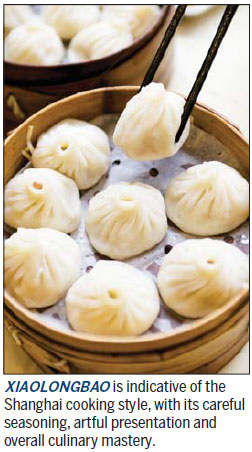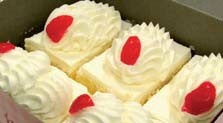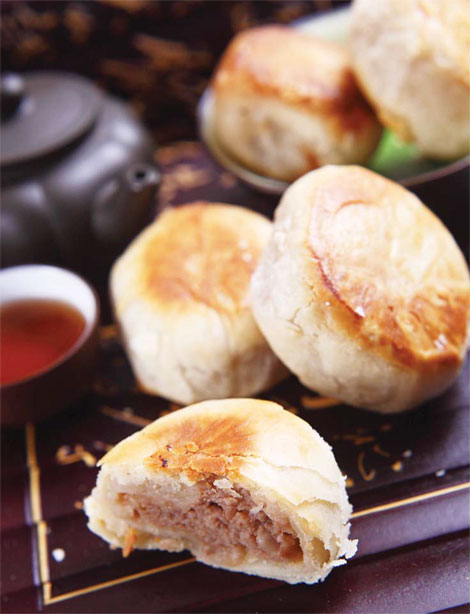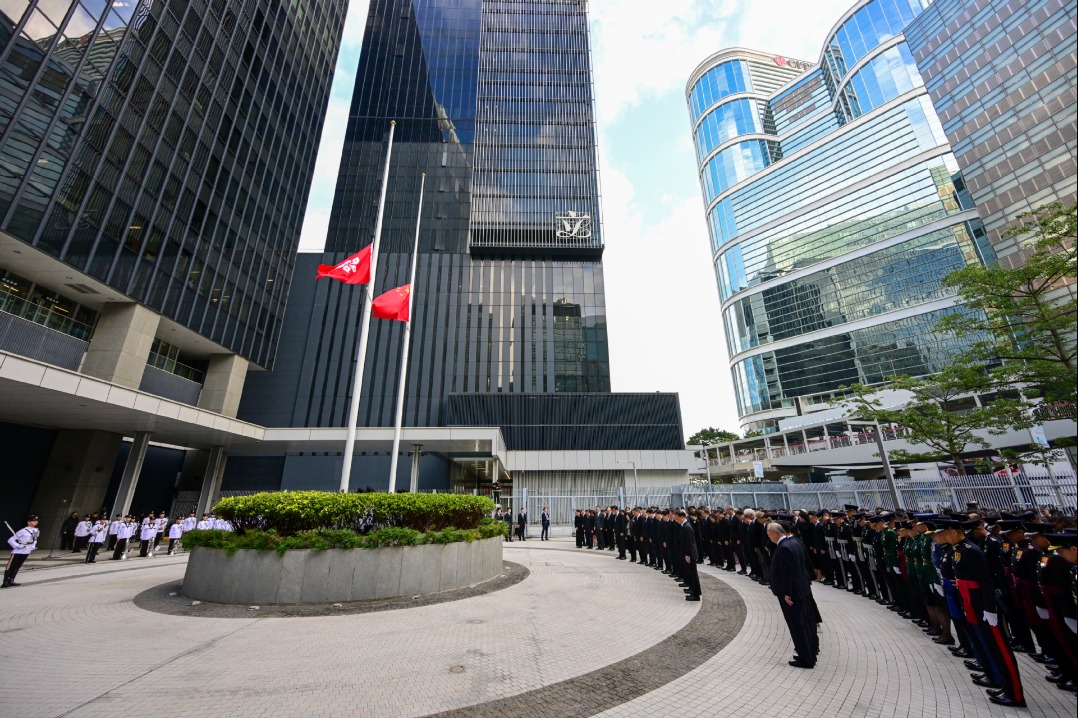Shanghai art of eating between meals

Editor's note: To understand China, sit down to eat. Food is the indestructible bond that holds the whole social fabric together and it is also one of the last strong visages of community and culture.
The steaming bamboo basket arrives at the table and there is a collective sigh of anticipation. Eager chopsticks reach out, carefully lifting up each dumpling by its pleated top.
It's placed on a spoon immediately and the top is delicately bitten off. Next, personal preferences may diverge.
| Meat mooncakes are baked, with a savory filling encased in flaky layers of the lightest pastry. Photos Provided to China Daily |
Some diners like to suck up the juices inside the dumpling immediately, relishing the essence of meat and ginger. Others like to leave the soup in the spoon while they happily munch up the skin and filling before sipping it up in a final culinary triumph.
Xiaolongbao, the soup dumpling, is an epicurean art in itself. It's also indicative of the Shanghai cooking style, with its careful seasoning, artful presentation and overall culinary mastery.
One of the first questions non-Shanghainese diners ask is, how do you get a mouthful of soup wrapped in such paper-thin pastry? And the answer is quite simple.
A gelatinous stock of skin and bones is slowly reduced and then chilled. The jellied mixture is mixed with meat to make the filling. When the dumplings are steamed, the heat melts the stock again and combines with the minced meat mixture, and there you go - soup dumplings.
Shanghai's little soup dumplings are available year-round, but in autumn, when the mitten crabs are fat and in season, they take on the accoutrements of haute cuisine. This is when crab meat is used in the filling, and a spoonful of golden roe is added to each little packet. The crab roe turns that mouthful of soup into delectable liquid gold.
Of course, other regions in China have their versions of soup dumplings. In Taiwan, for example, a certain restaurant actually won top placing in an international restaurant rating with its soup dumplings more than 10 years ago. They still boast about it.
Apart from soup dumplings, the next most popular snack in the city must be its fresh fried buns, or shengjianbao. These buns use thicker, slightly sweeter dough, but the filling is just as meaty.
While buns in other places are normally steamed, these Shanghai specialties are cooked in a flat skillet using a combination of frying and steaming. As a result, the sesame-crusted bottoms are golden and crisp while the dough on top is soft and fluffy.

A cramped pan of buns is first fried until the bottoms are nice and crisp, then water is liberally sprinkled to create steam to cook the tops - a technique that is also used for potstickers.
There are definitely two styles of shengjianbao: one has a dry filling; the other uses very juicy meat. Every Shanghai native has his or her favorite.
While xiaolongbao and shengjianbao are perhaps the more representative of Shanghai snacks, we cannot forget its meat mooncakes, or xianrou yuebing.
These are baked, with a savory filling encased in flaky layers of the lightest pastry. And no, they are not limited to just the Mid-Autumn season, but are also sold year-round.
It would be unpardonable if I did not next list the city's little wantons, xiaohuntun, among its savory snacks. The Shanghai version is not as plump as the Cantonese, nor as doughy as Tianjin or Beijing wantons.
Delicate clouds of wrapping float in a savory soup, dotted with chopped spring onions and maybe a sliver or two of laver. It's all about the smooth, silky skin, and often there is only a mere smear of meat as filling.
To many Shanghainese, xiaohuntun is the true taste of home.
Before I describe more of Shanghai's popular snacks, I must tell you about my favorite, which is usually only available around breakfast. These are glutinous rice rolls, or chifan, which are delicious sweet or savory.
Our Shanghai newsroom is in the heart of Huaihaizhonglu, the equivalent of Rodeo Drive, Saint Honore or Bond Street. Every morning, as the working crowds pour out of the metro stations, they may hurriedly stop by and grab breakfast from the itinerant vendors who have set up stalls by the exits. By 9:30 am or 10 am, these hawkers will have magically faded away, only to appear again the next day.
My favorite breakfast was sold by a ruddy-faced lady who managed to balance all her wares on the pillion of her bicycle. These included a steaming pot of glutinous rice, a bagful of fried dough fritters, or youtiao, several more containers of pork floss and chopped up Sichuan pickled vegetables and some sugar and seasonings. Half the fun was watching her assemble everything.
First, a large ladle of rice would go on a piece of plastic wrap. Then a section of youtiao would be pressed onto the rice, topped with spoonfuls of sugar, pork floss and lots of spicy pickled vegetables.
Next, she rolled up everything like sushi, twisted the ends of the plastic wrap shut, gave it a final twirl, and there you have it: a sweet and savory breakfast roll on the go.
These were very satisfying, and sometimes you didn't even need lunch. But by teatime it was time for a refill.
My colleagues were largely Shanghai natives, and female to boot. That's how I was introduced to some delightful Shanghai sweets.
There are the large, buttery butterfly puffs, light as air and apt to break apart even before they end up in the mouth. They are really nothing more than sugar-crusted puff pastries, but that doesn't stop them from being teatime favorites. The best, according to my colleagues, are from the bakery inside the International Hotel.
Something similar are the almond squares from the old Harbin Bakery, a time-honored brand that has stayed in the same location on Huaihailu for decades. Again, these are puff pastries with slivered almonds liberally sprinkled on top.
I only have space for the truly Shanghainese snacks, but any visitor would tell you that there is a lot more, from doughnuts to cronuts to true-blue Parisienne patisseries, like the best eclairs and macaroons in China.
paulined@chinadaily.com.cn
| Shengjianbao buns use thicker, slightly sweeter dough, but the filling is just as meaty. |
Red Ruby cream cakes
One of the surprises in Shanghai were the old-fashioned cream squares from a bakery named Red Ruby. In these days of fancy confections and elaborate creations, Red Ruby has continued turning out these rich cream cakes. My colleagues in Shanghai say these cakes have been popular for generations, and they are still coveted as gifts.

Again, these little cakes are a throwback to the times of the foreign concessions, and the original recipe has been carefully preserved and passed down to the present operators of the bakery.
What is the attraction in a square of vanilla sponge topped with butter cream and garnished with a dollop of red jam to reflect the Red Ruby name?
I think it's the taste of nostalgia. And in China, perhaps it is only in Shanghai that that memory has been so deliciously preserved.
(China Daily European Weekly 07/02/2016 page20)
Today's Top News
- Takaichi must stop rubbing salt in wounds, retract Taiwan remarks
- Millions vie for civil service jobs
- Chinese landmark trade corridor handles over 5m TEUs
- China holds first national civil service exam since raising eligibility age cap
- Xi's article on CPC self-reform to be published
- Xi stresses improving long-term mechanisms for cyberspace governance
































